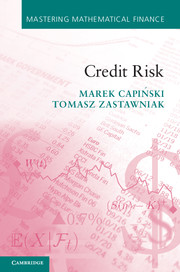Preface
Published online by Cambridge University Press: 05 January 2017
Summary
Credit risk is concerned with the possibility of bankruptcy happening as a result of unpaid debt obligations. This applies to companies partially financed by debt. The key question is to find the value of debt or, equivalently, the amount of interest charged by the debt holders to offset their possible loss due to bankruptcy. Our goal is to explain the main issues in the simplest possible cases, to keep the theory free of technical complications.
The first approach covered in this book relates bankruptcy to the company's performance. The resulting model is referred to as structural. Historically, this was the first systematic approach to credit risk, developed by Merton in 1974.
In the other method studied here, called the reduced-form approach, default occurs as a result of external forces, not related directly to the functioning of the company, and comes as a surprise at a random time. This may be the time when some information is revealed about technological advances, court decisions, or political events, which could wipe out the company.
We develop an approach similar to the classical financial theories, where certain underlying securities are specified and self-financing strategies are constructed from these. Here it is the risk-free and defaultable zero-coupon bonds that will serve as underlying assets. This makes it possible to price a range of defaultable securities, including Credit Default Swaps, by means of replication. Then, after adding a Black–Scholes stock as a building block of the market, the range of securities broadens, and this allows us to conclude with an example where the structural and reduced-form approaches come together.
Readers of the book need to be familiar with material covered in some earlier volumes in this series, namely [SCF] and [BSM], that is, with the foundations of stochastic calculus and the Black–Scholes model. Exposure to measure theory based probability, covered in [PF], would also be helpful.
The text is interspersed with various examples and exercises. The numerical work underpinning many of the examples, and solutions to the exercises, are available at www.cambridge.org/creditrisk.
- Type
- Chapter
- Information
- Credit Risk , pp. vii - viiiPublisher: Cambridge University PressPrint publication year: 2016



